|
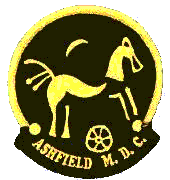
| |
|
LORD OF THE
RINGS |
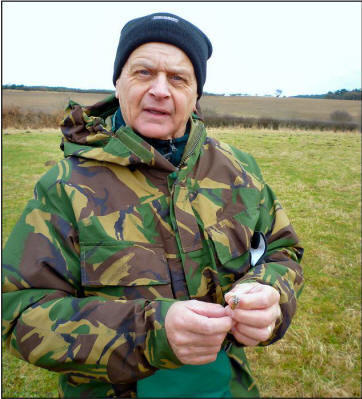 |

Alan Roberts with a ring he found on a recent carboot site
search held by the club. Although most of the club members
prefer other venues the shortage of searchable land, during
certain times of the year, makes the use of such sites
necessary. On the bright side most members come away with a few
pounds in spendable money enough usually to pay, at least, for
the cost of the search.
|
|
SEVENTEENTH
CENTURY TRADERS’ TOKEN |
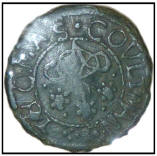 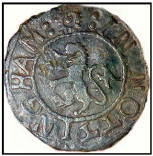 |
Found by John Radford on a club search in Nottinghamshire,
this token is previously unrecorded. It reads,
THOMAS COULTMAN IN NOTTINGHAM.
Nothing is known of any tradesman by this name, the lion may
refer to a public house.
|
|
TRADERS’
TOKENS |
|
In 1671 the amount of traders’ tokens in circulation in
England increased to such an extent that the government
announced the intended issue of halfpence and farthings to
supersede them. In 1672 a proclamation prohibiting the
making or use of any such private tokens was issued, and
stringent measures were taken for their suppression. From
that time their use rapidly declined and from 1672 until
1786 no traders’ tokens were struck in England. Then, due to
the lack of base metal coinage, in 1787 unofficial
production was resumed. |
|
FIND OF THE MONTH
FEBRUARY, 2011. |
| COIN:- |
|
 |
|
|
| ARTEFACT:- |
|
 |
JOINT
WINNERS
Richard
Waite.
Roman
Brooch
Dennis
Brown.
Horse
pendant.
|
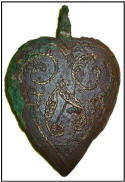 |
|
FIND OF THE MONTH
MARCH, 2011 |
| COIN:- |
|
 |
Gavin Phillips
King Henry 111 1216—1272 Long cross hammered
silver penny.
The cross served two
purposes, firstly to prevent the clipping of the
coin, if any of the arms of the cross was cut away
the coin ceased to be legal tender. Secondly to
enable the coin to be cut in halves or quarters to
make halfpennies and farthings this ceased in the
thirteenth century when round coins for these values
were introduced.
|
 |
| ARTEFACT:- |
|
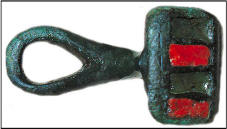 |
Dave
Rhodes
Celtic dress fastener.
|
|
MOST UNUSUAL
FIND IF THE MONTH, MARCH, 2011. |
|
 |
|
Dennis Brown. Brass " HIDDEN
DRAGON" name plate. |
|
FIND OF THE MONTH, APRIL,
2011. |
| COIN:- |
|
 |
| ARTEFACT:- |
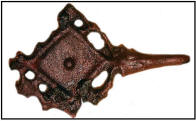 |
John Radford, Tudor
dress fastener |
|
FIND OF
THE YEAR, APRIL, 2010 to MARCH, 2011. |
| COIN:- |
|
 |
Richard Waite
Gold stater
|
 |
| ARTEFACT:- |
|
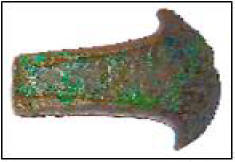 |
Bronze Age Axe head. 2000—1700bc.
Found by Dave Hallam. ( See PAS report
below.)
|
|
FIND OF THE MONTH, MAY, 2011. |
| COIN:- |
|

 |
James 1
half groat found by Derek Battle
|
| ARTEFACT:- |
|
 |
Shoe buckle 17/18th century found by
John Gough.
|
| MOST UNUSUAL FIND:- |
|
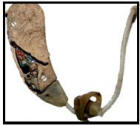
Hearing aid found by Dennis Brown. |
|
FINDS
MADE OVER THE PERIOD |
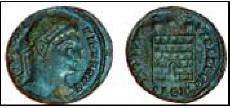 |
Jeff Oscroft.
Roman bronze coin of the house
of Constantine
|
 |
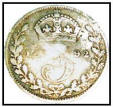 |
Richard Waite
Queen Victoria silver threepence,
dated 1892.
|
|
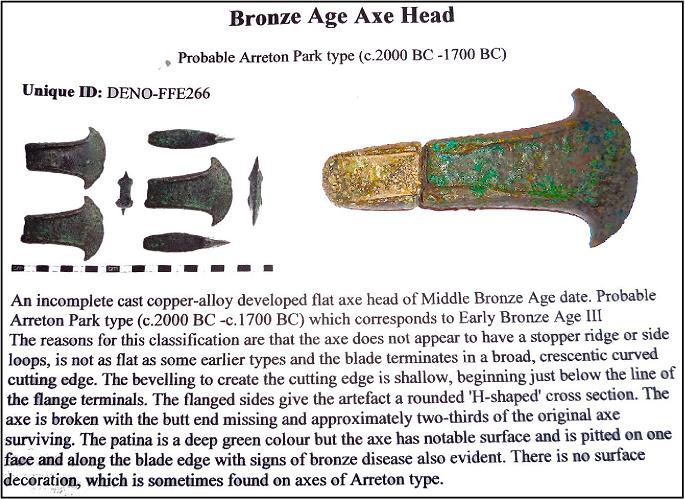 |
|
|
BRONZE AGE AXE HEAD
The axe head was found in
two parts, the larger part
(Find of the Year) by Dave
Halam in March, 2010 and the
smaller one, in the same
field, almost a year
afterwards by Dave Budding.
(The description and
report alongside was
prepared by the PAS FLO
Charlotte Burrill.)
*** |
|
|
James V1 of Scotland
acceded to the English
throne upon the death of
Elizabeth I in 1603
becoming James I He is
well known for upsetting
the Catholics by
imposing heavy fines on
anyone not attending
Protestant church
services which
eventually lead to the
infamous Guy Fawkes and
the gunpowder plot.
This Scottish Merk of
1603 was recovered by
Dave Rhodes.
|
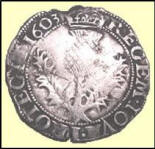 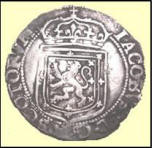 |
|
FIRSTS FOR CLUB
MEMBERS |
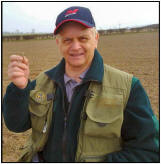 |

Alan
Roberts with his
first Roman brooch
|
 |

John
Wilkinson with his
first Roman brooch
|
 |
Pete Dawson with his
first tractor jack |
|
FIND OF THE YEAR
2010 - 2011
AWARDS. |
|
 |
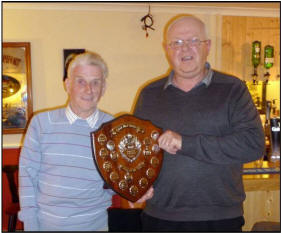 |
|
Richard Waite
being presented
with the coin
Find of the
Month Award by
the Club
chairman, Dave
Hallam.
Gold Stater
|
Dave Hallam
being presented
with the
artefact Find of
the Month Award
by Dennis Brown,
previous club
chairman.
Bronze Age Axe
Head. |
|
CHAIRMAN'S
AWARD |
|
DETECTORIST
OF THE YEAR |
|
 |
|
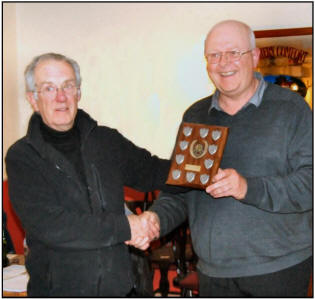 |
|
Gavin
Phillips
proudly
displays the
cup
presented to
him by the
club
chairman. It
is awarded
to the
member who,
in the
opinion of
the
chairman,
has done the
most to live
up to the
spirit of
the club in
the past
year.
|
|
Dave Hallam,
club
chairman,
presenting
the
Detectorist
of the Year
shield to
Jeff
Oscroft. It
is for the
detectorists
who has
accumulated
the most
Find of the
Month points
during the
last club
year.
|
|
"WASTE
OF TIME
TEAM"
DIG. |
|
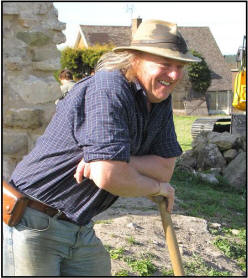 |
|
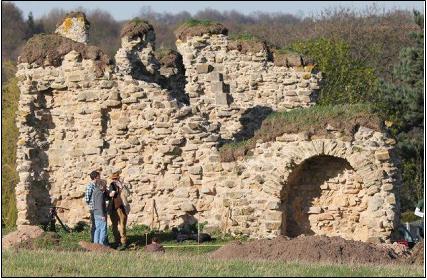 |
|
Philip
(Phil)
Harding
(born
1950) is
a
British
field
archaeologist
who has
been a
regular
member
of the
Time
Team
from the
first
series
in 1994
to the
present.
(Photograph
by
Anthony
James,
taken at
the
Clipstone
dig.)
|
|
King
John's
Palace,
Kings
Clipstone,
as
photographed
by David
Hallam,
during
the
recent
Time
Team
dig.
David
managed
to take
this and
the
following
photographs
before
being
escorted
from the
site.
Although
he had
assisted
the Time
team on
the
Codnor
Castle
dig he
was not
allowed
on site
at
Clipstone! |
|
KING JOHN'S
PALACE. |
|
When King
John’s
Palace was
first built,
sometime
before 1164,
it was a
timbered
structure.
In 1180 it
was rebuilt
in stone to
become the
principle
hunting
lodge and
royal
residence in
Sherwood
Forest.
Royal
visitors to
the lodge
included
Henry 11,
Richard 1,
John, Henry
111, Edward
1, Edward
11, Edward
111, and
Richard 11.
Many of the
royal
visitors
stayed for
weeks or
months at a
time which
meant that
the
accommodation
must have to
a high
standard,
although it
is recorded
as being in
a ruinous
state in
1525.
Another
indication
of the
importance
of the
building was
that Richard
1 met
William King
of Scotland
in 1194 and
Edward 1
held
Parliament
there in
1290. It was
one of the
first three
listed
buildings
the others
being
Stonehenge
and
Fountains
Abbey.
King John
was born in
1167 and
died in
1216, he
reigned from
1199 to
1216.
*** |
|
BIRMINGHAM
BUTTONS |
|
(Knight’s
Penny
Magazine
for the
diffusion
of
useful
knowledge
1844) |
|
Buttons
are
among
the most
remarkable
manufactures
of
Birmingham,
and one
of the
few
which
are
conducted
on what
may
fittingly
be
termed
the
factory-system,
since
there
are
establishments
in which
some
hundreds
of
persons
(five or
six
hundred
in one
instance)
are
employed
in one
building,
all
making
buttons.
It is
indeed
surprising
to see
the
extent
to which
so
trifling
an
article
influences
manufactures,
when
once it
has
become a
ruling
item of
fashion.
Button-makers
are now
among
the
best-employed
artisans
of the
town.
Half a
century
ago
Hutton
spoke of
the
button-trade
at
Birmingham
in the
following
quaint
terms
“This
beautiful
ornament
appears
with
infinite
variation;
and
though
the
original
date is
rather
uncertain,
yet we
well
remember
the long
coats of
our
grandfather’s
covered
with
half a
gross of
high-top,
and the
cloaks
of our
grandmothers
ornamented
with a
horn
button
nearly
the size
of a
crown-piece,
curiously
wrought,
as
having
passed
through
the
Birmingham
press.”
Though
the
common
round
button
keeps in
with the
steady
pace of
the day,
yet we
sometimes
see the
oval,
the
square,
the pea,
and the
pyramid
flash
into
existence.
In some
branches
of
traffic
the
wearer
calls
loudly
for new
fashions;
but in
this the
fashions
tread
upon
each
other
and
crowd
upon the
wearer.
The
consumption
of this
article
is
astonishing,
and the
value
from
three-pence
a gross
to one
hundred
and
forty
guineas.
There
seem to
be
hidden
treasures
couched
within
this
magic
circle,
known
only to
a few,
who
extract
prodigious
fortunes
out of
this
useful
toy,
whilst a
far
greater
number
submit
to the
statute
of
bankruptcy.
Trade is
like a
restive
horse
and can
rarely
be
managed;
for
where
one is
carried
to the
end of a
successful
journey,
many are
thrown
off by
the way.
Buttons,
it must
be
owned,
are not
now such
splendid
affairs
as they
were in
Hutton's
time,
but the
trade
has
probably
vastly
increased
in
extent.
The
materials
of which
buttons
arc made
are very
various,
and this
variety
gives
rise to
a
subdivision
somewhat
akin to
that
which we
have
already
noticed
although
not so
marked.
Besides
the well
known
gilt
buttons,
plain
and
figured,
there
are
plated
silk,
florentine,
and
other
covered
buttons,
pearl,
horn,
shell,
bone,
wood,
glass,
and
porcelain
buttons,
and
probably
many
others.
The
establishments
of Mr.
Elliott
and of
Messrs.
Hammond
and
Turner,
two of
those in
which
buttons
are made
to a
vast
amount,
are
among
the most
interesting
in
Birmingham.
The
former
of these
factories
consists
of a
number
of
distinct
buildings
encompassing
an open
area or
court,
and each
devoted
to a
particular
kind of
button-making,
or a
particular
department
of the
general
manufacture.
The
number
of
females
to which
the
process
gives
employment
is very
large,
and the
nimbleness
with
which
most of
the
processes
are
carried
on by
them is
truly
remarkable..
(To be
continued
if so
required………….) |
|
Stamping,
pressing
and
punching
buttons,
Elliott’s
factory,
Birmingham
1840. |
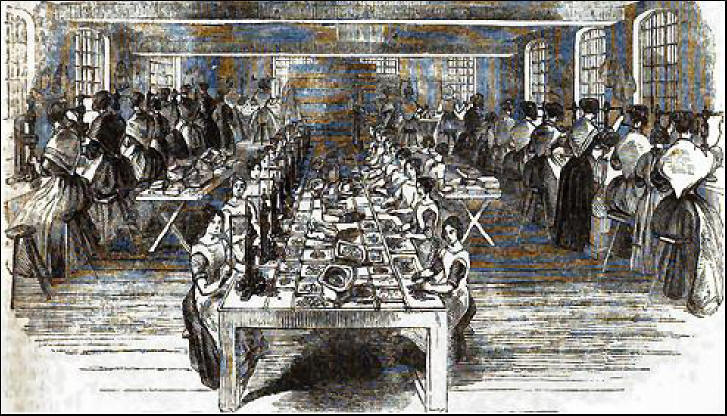 |
|
*** |
|
DISPLAY OF BUCKLES |
 |
|
Dennis Brown brought this superb display of buckles in case to the club at the May meeting. The display case is made out of a picture frame with glass mounted on a simple frame using two small brass hinges.
The buckles can be dated from Roman to relatively modern times.
They have been carefully cleaned and preserved by Dennis. Well worth viewing.
*** |
|
BUSTS ON ROMAN COINS THAT MAY BE FOUND IN BRITAIN (7) |
 |
CARINUS 283—285.
M. Aurelius Carinus was born about A.D. 249 the elder son of Carus. He was made Caesar and when his father and younger brother left for the Eastern frontier he stayed in Rome to tend to affairs. He was raised to Augustus in A.D. 283. In a battle near Verona he defeated Julianus and then advanced against Diocletian. During the battle he was murdered by one of his own officers and his troops joined Diocletian.
DIOCLETIAN 284—305.
Gaius Aurelius Valerius Diocletianus was born at Split, Dalmatia in A.D. 245. He became Commander of the Imperial Guard becoming emperor in A.D. 284 after Numerian was assassinated. He established a tetrachy of two Augusti and two Caesars but retained the right to make final decisions. Diocletian introduced many reforms including the coinage. He reigned for twenty years passing his old age in retirement.
Carausius 286—293 (In Britain)
Marcus Aurelius Maus Carausius was born in the Netherlands. He became commander of the Channel Fleet tasked with clearing the North Sea of pirates. He was successful but failed to hand over recovered booty to Maximian who condemned him to death. Carausius fled to Britain and was proclaimed Emperor by his troops. Surviving invasion attempts he was assassinated in A.D. 293 by Allectus his finance minister.
ALLECTUS 293—296 (In Britain)
Details of his birth are unknown. He was either the finance minister or Praetorian Prefect to Carausius. After assassinating Carausius in A.D. 293 he was declared Augustus by the troops in Britain. Constantius being in Gaul prepared a fleet, invaded Britain and defeated the forces of Allectus in A.D. 296. Allectus either committed suicide or was killed during the battle. Britain then came back under the rule of Rome.
MAXIMIAN 286—305 1st. Reign, 306—308 2nd. Reign, 310 3rd. Reign.
Marcus Aurelius Valerius Maximianus Herculius was born about A.D. 250 in the Balkans. Diocletian raised him to Caesar in A.D. 284 and to Augustus in A.D. 286 responsible for the Western Empire. He made his headquarters in Gaul and restored order to the province. He abdicated in A.D. 305 returning in A.D.306 to abdicate again in A.D. 308. later he rebelled against Constantius and committed suicide in A.D. 310.
CONSTANTIUS 293—305 as Caesar 305-306 Augustus
M. Flavius Valerius Constantius was born in the Balkans in A.D. 250. Serving in the military he became governor of Dalmatia and then made Caesar in A.D. 293. In A.D. 296 he successfully invaded Britain and restored it to the empire. In A.D. 305 he became Augustus. While campaigning against the Picts he became seriously ill and died at York in A.D. 306..
|
|
BOOKS |
|
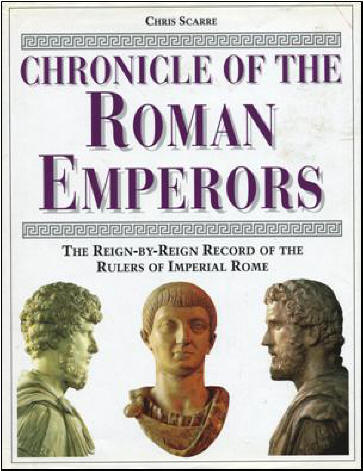
|
CHRONICLE OF THE ROMAN EMPIRE
In this issue of the newsletter I would like to introduce you a book by Chris Scarre, Chronicle of the Roman Empire. This is a hard cover book published in 1995 by Thames and Hudson.
The cheapest I could find it on the Internet was at Amazon £6.85 and £2.30 postage from Goldstone books.
It has 328 illustrations 111 in colour and includes coin portraits and busts of each emperor, maps and battle plans and cutaway diagrams of imperial monuments. It gives biographical accounts of all the emperors from Augustus to Constantine the personalities and eccentricities of the famous Claudius, Trajan, Hadrian, Diocletian and the infamous Caligula, Nero, Caracalla, and Elagabalus.
I would like to recommend this book to fellow detectorists.
|
|
GREAT SEAL OF THE KING OF ENGLAND. HENRY V 1413—1422. |
|

*** |
Ashfield Metal Detecting Club reserves the right not to be responsible for the
correctness, completeness or quality of the information provided in this newsletter
and does not, necessarily, support the views of the contributors
***
|
Please note that the illustrations in the newsletters are not to scale.
*** |
|
